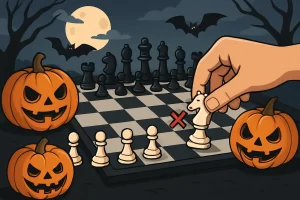Call us now:

In the shadows of majestic endgames and middlegame fireworks, there’s a peculiar fascination that grips even seasoned chess enthusiasts: the allure of the fastest checkmate.
It’s a mix of shock, precision, and — let’s face it — a little schadenfreude when a match ends in mere seconds. Whether you’re a complete beginner stumbling into bait or a grandmaster spotting an opponent’s lapse, the fastest checkmate in chess is a phenomenon that stirs up laughter in local clubs and dread in online leaderboards.
As a competitive player, coach, and longtime student of the game, I’ve seen these miniature masterpieces both as ruthless victories and horrifying defeats. Today, we’re going to dissect them in totality — the moves, the why, the history, the humour, and the lessons they leave behind.
Let’s venture deep into 2-move checkmates, Fool’s Mate, blunder traps, and what these lightning-fast defeats teach us about the game itself.
Table of Contents
- What Is the Fastest Checkmate in Chess?
- The Fool’s Mate: Checkmate in 2 Moves
- Move Breakdown: Fool’s Mate Explained
- Why the Fool’s Mate Happens
- Top 5 Fastest Checkmates in Chess
- Fastest Checkmates in Professional and Tournament Play
- Avoiding Fast Defeats: What Beginners Should Watch For
- Fastest Checkmates for Black Players
- Fact vs Fiction: Are 1-Move Checkmates Real?
- FAQs: Quick Answers to Quick Finishes
- Conclusion: The Art Behind the Speed
What Is the Fastest Checkmate in Chess?
The answer to this is brutally simple: Fool’s Mate. It’s the shortest possible checkmate in modern chess — and yes, it happens more often than you’d think in blitz and beginner games. The game ends in just two moves with a precise sequence that leaves the king stranded and helpless.
Let that sink in.
While most players dream of multistep combinations and endgame zugswangs, Fool’s Mate is the laughing skull of the chess world — a trap door waiting beneath the floorboards.
But to understand why it’s possible, and how it happens, we need to look closer.
The Fool’s Mate: Checkmate in 2 Moves
Fool’s Mate occurs only when White commits egregious errors by opening up dark-square weaknesses near the king. Then, Black capitalizes using the queen with devastating efficiency.
Here are the exact moves:
- 1. f3 e5
- 2. g4 Qh4#
That’s it. The white king is cornered, the f-pawn and g-pawn create a direct channel, and Black’s queen delivers checkmate. No fancy tactics. No need to bring out five pieces. Just one catastrophic opening from White — and the lights go out.
‘Like lighting a match in a dry forest,’ as a fellow IM once said to me, ‘the fire spreads before you realize you’re burning.’
⚠️ Let’s be clear:
This position cannot occur unless White makes critical errors in the first two moves. It’s unforced. Nobody should fall into this… unless they’re brand-new to the game or doing something reckless like bullet-blitz spam clicking.
Move Breakdown: Fool’s Mate Explained
Let’s break this checkmate down to truly grasp its anatomy.
| Move # | White | Black |
|---|---|---|
| 1 | f3 | e5 |
| 2 | g4 | Qh4# |
- 1. f3: White weakens e1-h4 diagonal. It’s also a wasted tempo. Worse, it does nothing to develop a minor piece or control center.
- 1… e5: Black develops a central pawn, aiming to free the queen and bishop.
- 2. g4: This commits the cardinal sin. Another pawn weakens light squares — now the bishop and f3 pawn are no help.
- 2… Qh4#: The queen swoops in diagonally. The king on e1 cannot escape:
- f2 is occupied by its own piece;
- g2, f3, and e2 are defended or occupied;
- The g4 pawn provided the attack lane.
It’s violent. It’s startling. It’s over.
Why the Fool’s Mate Happens
The Fool’s Mate isn’t so much a “combination” as an accident.
It thrives in three scenarios:
- Beginners experimenting: Especially while learning moves, a player might move f- and g-pawns unaware of consequences.
- Bullet-speed games: At 30-second time controls, some people click fast and think slow. Exact blunders like f3 and g4 can and do pop up.
- Trap attempts gone wrong: Inexperienced players trying to mimic traps like the Scholar’s Mate might end up misplaying critical moves.
Let me emphasize — a competent player will never stumble here. But that doesn’t mean this checkmate doesn’t matter. On the contrary, it teaches us the importance of square control, king safety, development, and tempo — all at once.
Top 5 Fastest Checkmates in Chess
Let’s step beyond Fool’s Mate and look at other blisteringly fast finishes.
1. Fool’s Mate (Checkmate in 2 Moves)
- 1. f3 e5 2. g4 Qh4#
- Fastest. Rarest. Embarrassing.
- Only exploitable from Black side.
2. Scholar’s Mate (Checkmate in 4 Moves)
- 1. e4 e5 2. Qh5 Nc6 3. Bc4 Nf6?? 4. Qxf7#
- Classic “greedy queen” opening.
- Often seen in novice vs novice play.
- Targets weak f7 (or f2 if reversed), which is only protected by king.
3. Legal’s Mate (Mate in 7 Moves)
- A clever knight sacrifice leads to a surprise queenless checkmate.
- Often misunderstood because White gives up the queen willingly.
- Great display of development and tempo.
4. Blackburne’s Mate (Fast Bishop Trap)
- Name comes from Joseph Henry Blackburne.
- Utilizes two bishops and a queen for a surprise finish against g6 setups.
- Common in aggressive attacking lines like King’s Gambit.
5. Reti’s Mate (Fianchetto Finish)
- Uses long-range control from bishops after deep fianchetto structures.
- Seen in symmetrical setups.
- Less about speed, more about underestimation of back-rank themes.
These tactical blueprints, while varying in length, all capitalize on conceptually fast executions — mostly due to poor defense and underestimated threats.
Fastest Checkmates in Professional and Tournament Play
You may wonder, “Surely Grandmasters don’t fall for this?”
For Fool’s Mate? Never.
But fast checkmates absolutely happen — even at the highest levels. The key difference is that the really short wins by professionals don’t come from opening blunders, but from deeply set traps, positional destruction, or psychological manipulation.
One infamous example:
- In under 10 moves, a Grandmaster crushed a top-seed after a misplayed French Defense. The line wasn’t cheap — it followed theory — but turned killer after one obscure move.
- No silly pawns or blunders. Just relentless attacking logic that cornered the king in minutes.
Another story I remember vividly involved a candidate’s tournament where a high-level player resigned in 11 moves due to irreversible piece loss and exposed king. The moves weren’t “bad,” they just added up to disaster.
Grandmasters don’t blunder. But they miscalculate pressure — and that’s often enough.
Here’s a table showing some of the shortest pro-level games ever played:
| Game | Moves | Winner | Event |
|---|---|---|---|
| Gibaud vs Lazard | 4 | Lazard | Paris |
| Kostic vs Maroczy | 6 | Maroczy | Vienna |
| NN vs Morphy | 6 | Morphy | Casual |
| Troitsky vs unknown | 5 | Troitsky | Blitz session |
Avoiding Fast Defeats: What Beginners Should Watch For
If you’re starting out with chess, fast losses can be devastating. But they teach critical lessons.
Here’s what to avoid in your first few moves:
❌ Don’t:
- Move f- and g-pawns early without reason
- Ignore center control (e4/d4)
- Move the queen out too early
- Mimic patterns without understanding intent
✅ Do:
- Prioritize minor piece development (knights/bishops)
- Castle early
- Monitor diagonals toward your king
- Ask: “If I move this, what can my opponent do in response?”
In short, avoid beginner’s blindness — the belief that your move ends the turn. It never does. It simply begins your opponent’s counter-attack.
Fastest Checkmates for Black Players
While White typically dictates the opening, some of the most savage fast mates actually come from the Black side — particularly traps against e4.
One notable sequence, countering the King’s Gambit Gone Wrong:
- 1. e4 e5 2. f4 exf4 3. Bc4 Qh4+!
- King walks into a firestorm.
- A few awkward bishop blocks later, mate on f2.
Another lethal trick: the Boden’s Mate from the Black side using dual bishops against a castled king caught behind its own pawns.
Fact vs Fiction: Are 1-Move Checkmates Real?
No. Flatly: There is no legal one-move checkmate from a standard opening position.
However, there are staged, puzzle, or artistic compositions where pre-placed positions allow for immediate mates — such as mating with Ng3# in a made-up puzzle.
But in real rules? Two moves is the absolute minimum. Anything claiming otherwise is parody or misinformation.
FAQs: Quick Answers to Quick Finishes
Q: Can I win chess in 2 moves with White?
No. Fool’s Mate is only possible from Black’s side.
Q: Is Fool’s Mate named after someone?
No — it’s not named after a person. It represents the “foolish” blunders required to allow mate in two moves.
Q: How common is Fool’s Mate in actual play?
Rare at club level. Occasional in online bullet or among beginners.
Q: What’s the easiest fast trap I can set up?
Scholar’s Mate. It’s simple, instructive, and forces awareness about piece vulnerability.
Conclusion: The Art Behind the Speed
The power of the fastest checkmate lies not just in its brevity, but in what it reveals:
- Poor pawn structure? Punishable.
- Neglect center control? Fatal.
- Undeveloped pieces? Dangerous.
- Overextended ambition? Exploitable.
Whether it’s Fool’s Mate, the crisp Queen snipe of Scholar’s Mate, or a historic blitz blunder by a Grandmaster, fast checkmates illuminate one core truth: chess punishes ignorance quickly and decisively.
Master the opening. Respect the basics. And if you do deliver (or suffer) one of these fast mates — laugh, learn, and play again.
Because nothing teaches faster… than losing fast.



